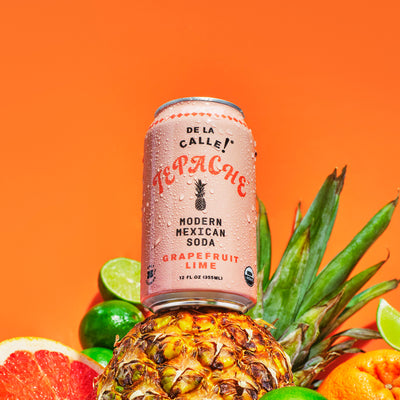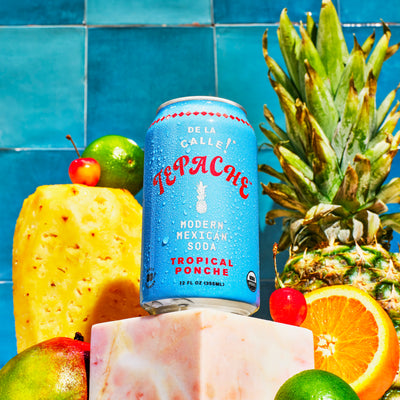A Complete History On the Tepache Recipe

In this article, we’ll give you a brief overview of Tepache then dive into its history, the evolution of the recipe, its popularity today, and a little bit of information about the nutritional value of this beverage.
What is Tepache?
Today, Tepache is a sweet, bubbly drink made from fermented pineapple . Although it may appear alcoholic at first, Tepache actually has a very low alcohol content, much like kombucha. Pineapple is used to make Tepache because of its distinctive flavor..
There’s several hundred variations of the Tepache recipe, some calling for additional fruits and spices, but the three consistent ingredients are pineapple,cinnamon, and sugar, most commonly panela, a type of unrefined whole cane sugar popular in Central and South America. Each region in Mexico makes tepache in their own unique way, resulting in hundreds of different recipes.
Tepache is usually served cold over ice and is wildly popular in Mexico at restaurants, bars, and taquerías. However, Tepache is most commonly sold on the street, usually iced in a baggy with a straw, making it the perfect refreshing, portable beverage. Given the widespread variation in the recipes, simpler versions of this delicious drink are also made at home.
Flavor
The wide variety of Tepache recipes that exist also mean that there’s no one specific Tepache flavor. However, for the most part Tepache is an orangey-beige carbonated drink that has a light, sweet flavor. It tastes somewhat like a cider but has a delicious pineapple aftertaste that gives this drink a unique, exciting twist.
Production Process
Although each variety of tepache is made differently, the basic steps of the process are the same for this traditional Mexican beverage. First the pineapple is prepared by slicing it such that the peels and core are separate from the fruit.
The pineapple pulp is then placed in water with cinnamon and brown sugar. The mixture is then covered and ferments for 2-3 days before it is ready to be served over ice.
The Original Recipe
Tepache dates back to pre-colombian Mexico, making it a centuries old favorite. It is believed that the earliest forms of Tepache were made either by the Nahua people of central Mexico or the Mayans. For the Mayans, Tepache was a sacred drink to which they would add different aromatics depending on its intended use.
The word Tepache itself comes from the Nahuatl word tepiātl which translates to “drink made from corn”. The word tepiātl is a conjunction of the word tepitl which means “tender corn” and atl which means “water”. The influence of the Nahuatl word tepachoa is also seen in the name tepache. Tepachoa means “pressed or ground with a stone.” That being said, Tepache roughly translates to “crushed corn drink.”
This translation points to the original Tepache recipe which used maize (corn) as the base. Although Tepache eventually evolved into a pineapple-based beverage, there is still a corn-based drink similar to Tepache that is called tejuino.
Nahua People
The name Nahua comes from the umbrella term for the Nahuan languages, Nahuatl. The Nahua people are the indigenous people of Mexico and El Salvador primarily, although there are also Nahuas in Guatemala, Honduras, and Nicaragua. Today, the Nahuas are the largest indigenous group in Mexico. The Aztecs and possibly the Toltecs are thought to be of Nahua ethnicity.
Although the Nahuatl language unites the Nahua people, there are several variations of this language.The Nahua people organized themselves into tribes and identified strongly with their tribal ties.
Evolution of the Tepache Recipe
Overtime, the Tepache recipe evolved to use the pineapple, namely the pulp, as the base.
It is thought that fruit was originally added to the recipe to sweeten the drink. At first, only small chunks of pineapple were used because it was hard to access pineapple all year round. Once trade routes opened up and pineapple became easy to access at all times, the delicious, sweet fruit replaced corn as the base of Tepache.
The reason that there’s not an extremely well documented history of the Tepache recipe is because it is a drink that’s often made in the home and has escaped the heavy taxation that the colonizers placed on other traditional foods and drinks. This meant that the production of Tepache was never standardized and instead evolved fluidly from one region to another.
Varieties
Given that Tepache is a traditional drink with no strict recipe, several varieties exist.
One of the more common types of Tepache is called tepache de tibicos. Fermented tibicos, also known as water kefir, are sometimes used to brew Tepache.
Other variations of Tepache call for the addition of fresh lime, cloves, and chopped fruit. Some types of Mexican Tepache even contain tobacco to give this traditional drink a smoky twist.
Popularity Today
Tepache is becoming increasingly popular today outside Mexico, especially in the U.S. Many bars in the U.S. are using Tepache in cocktails as a simple syrup replacement, pairing this rich, flavorful drink with mezcal, tequila, rum, and other liquors.
Health Benefits
That being said, Tepache on its own is also growing in popularity due to its incredible health benefits from the natural probiotics and nutrients in the beverage and its delicious flavor.
Tepache is an incredibly healthy drink, much like its better-known cousin kombucha. Given that Tempache has a pineapple base, it is rich in essential nutrients like manganese, vitamin C, calcium, and phosphorus. The vitamin C in tepache also makes it incredibly rich in antioxidants.
Because Tepache is made through a fermentation process, this delicious drink is also great for your gut, helping develop strains of bacteria that our bodies need to digest food properly.
Alcohol Content
Although Tepache technically contains alcohol due to the fermentation process, the alcohol content is so low that it is not considered an alcoholic beverage. On average, tepache contains 1-3% ABV, although the precise amount depends on the length of the fermentation period. The usual ABV for beer is around 5%, around 12% for wine, and nearly 40% for liquor.
Conclusion
Tepache is a traditional Mexican drink that was made by indigenous people for several centuries before the arrival of Columbus and is still wildly popular today. Originally made using corn, the tepache recipe evolved overtime, and it is now made using fermented pineapple peels and cores, cinnamon, and panela.
Although there are several varieties of Tepache, it is known for its light, bubbly texture and sweet pineapple flavor. Tepache is made all over Mexico, oftentimes in homes, which accounts for the wide varieties of Tepache available.
Due to the rise of specialty cocktail bars and the health food movement, Tepache is growing in popularity outside of Mexico and is often compared to kombucha. Tepache is a nutrient-rich, healthy beverage with a long history, making it a distinct, delicious part of traditional Mexican culture.
Sources:
https://www.healthline.com/nutrition/benefits-of-pineapple
https://www.iwgia.org/en/mexico.html
https://www.nationalgeographic.org/encyclopedia/aztec-civilization/











